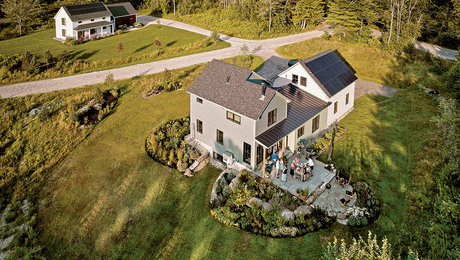If I replace a 10′ section of copper supply line between my hot water heater in the bsmt and my 2nd floor apartment with a larger diameter copper pipe, will my bathroom tub fill up quicker? I would like to understand what effect, if any, increasing the diameter of a section of supply line has on flow of water. My guess is that it would have no effect because the line going into the HW heater remains the same and the section of pipe just before the tub faucet also remains the same.
Discussion Forum
Discussion Forum
Up Next
Video Shorts
Featured Story

By considering things like energy-efficient mechanicals, window orientation, and renewable energy sources, homes can be evaluated to meet the energy codes. Here's what the IRC has to say.
Featured Video
How to Install Cable Rail Around Wood-Post CornersHighlights
"I have learned so much thanks to the searchable articles on the FHB website. I can confidently say that I expect to be a life-long subscriber." - M.K.

















Replies
It could depend on the size of your valve.
I would think that for a 10 section you won't see any change. The valve would be your next limiting factor.
negligible. The size of the WHOLE supply would need to be increased, and it then still depends on other factors like head, pressure, and valve restrictions.
Welcome to the
Taunton University of Knowledge FHB Campus at Breaktime.
where ...
Excellence is its own reward!
You are right and you are wrong or partially. All pipes have friction (not the correct technical term) losses. Bigger pipes have less so more water is delievered for any given length of pipe and presure. So, you are right in that your pipe size leading into your water heater is the major limiting factor. The pipe size leading from the tank to the tube is far less important, but a factor. My guess is the difference between a 1/2" and a 3/4" pipe would be next to nil, given the limits of teh infeed pipe to teh tank.
You'll have more cold water to empty out of the larger pipe so it will take longer to get hot water. Don't know how significant a 10' section would be though.
Good comment. I never thought about the additional water in the larger pipe. But, is your answer that my tub will fill quicker with the substitution of the larger pipe but that the water in the tub will be cooler? Or, are you saying that my tub will fill no quicker and also, the tub water will be cooler?
I don't think it will fill any faster overall because the size of the pipe upstream is smaller and the water will be cooler for longer when you first turn it on.
Edited 12/2/2006 3:22 pm ET by Gimby
Your water flow will be based on the smallest restriction in the line between the street (or well) and your point of use. Start at the meter and figure our what your smallest point is and there's not much of a need to go too much larger than that. A 2" line that you're talking about won't do much of anything other than delay your hot water as previously mentioned.
It won't fill up noticably quicker unless the present section of pipe offers significantly more restriction than the rest of the system.
For example, if you had 2" pipe in most of the system, but a portion of it was ½" pipe, then replacing the ½" pipe with larger pipe would help. If the whole system was ½" pipe, and you replaced a short section with 2" pipe, almost nothing would happen.
So, only if the 10 foot section were smaller than the pipes supplying it would it be worth the trouble.
Rick:
I suspect you won't realize a significant increase in "fill rate" by replacing the pipe...
To address a couple of previous comments - you WILL result in an additional delay before you start getting hot water into the tub. Exactly how "long" is a function of how much additional cold water volume must be flushed out of the standing pipes before the inrush of hot makes it to the tub. A simple calculation substituting 3/4" for 1/2" copper (and assuming these are INSIDE diameters rather than outside), comes out to 212.1 cubic inches of water (in a 10' 3/4" pipe) vs. 94.2 cubic inches (for 1/2"). {good old "pie-R-squared-times-length"} The difference (117.9), converts to about 65 ounces (roughly 1/2 gallon). You'll need to know how quickly the water is flowing when you open the tap (gallons per minute) to determine how much additional time is involved...
Larger diameter pipes (of the same material & finish) absolutely have less resistance to flow than smaller diameter pipes. However, this effect really only becomes appreciable at higher flow rates. (try sucking soda through a thin straw vs. a thick - doesn't make too much difference when you're not sucking very hard...)
I suspect that if you're unhappy with how quickly your tub fills up (and I'm assuming you don't have unrealistic expectations - ie., you've filled up lots of tubs before in other houses, hotels, etc. and they all seemed to fill up much faster!), that your problem might be inadequate pressure. Bringing it up to the 2nd floor from the basement can reduce the delivery pressure significantly - particularly if your supply pressure is low to begin with...
EDIT - to add...
If you have reason to believe that you have adequate pressure, than you need to identify where the effective "flow restrictor" is in your system - ie., the narrowest constriction in the end-to-end path, and try to "enlarge" it. You might want to look at butterfly shutoff valves that are partially closed, gross sediment buildup in certain sections (hard water?), kinked plumbing, etc...
Edited 12/2/2006 11:36 pm ET by willflysatellitesforfood